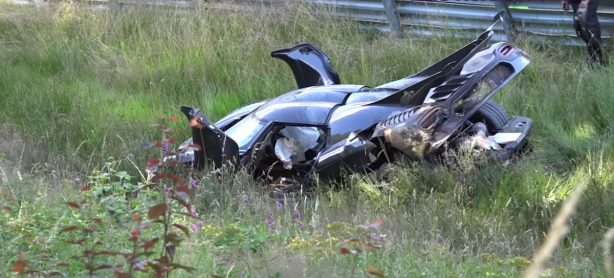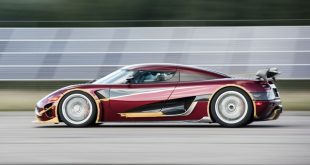An ultra-rare and super-exotic Koenigsegg One:1 endured a severed crash at the Nürburgring Circuit in Germany last week while attempting to set a new lap record for a production car.
The 986kW (1,361PS) hypercar crashed during a high speed testing and set up run, where it lost control at the Adenauer Forst section before hitting a guardrail. The impact was so great that the hypercar burst into flames but was quickly extinguished.
Luckily, the driver reportedly escaped without injury.
Today, Koenigsegg released findings of the accident after examining both the car and on-board telemetry. Here is what the Swedish manufacturer has been able to deduce:
“The One:1 experienced front axle brake lock-up at approximately 170 km/h on a section of the track known as Fuchsröhre before hitting the fence at Adenauer Forst at approximately 110 km/h. The impact with the fence launched the car into the air for an estimated 22 meters while it turned 180 degrees before it landed on its left rear wheel and pivoted to land parallel with the fence. The airbags, fuel shut-off and other safety systems all deployed as they were designed to do.
There was a small fire in the rear section of the car due to contact between the carbonfibre rear panels and the exhaust upon landing. This fire was extinguished by the driver using a fire extinguisher that was located inside the car.
The accident has been traced to a fault with the front left ABS wheel sensor signal.
Data analysis shows that the dashboard ABS warning light was triggered as soon as the ABS wheel sensor malfunction occurred. The small yellow ABS warning light is located centrally in the dashboard but may be difficult for the driver to see when he is wearing a helmet and concentrating on high-speed driving around the circuit. The driver may not necessarily notice any difference in the braking feel as long as he is not near the ABS braking zone, i.e. braking hard enough that it would have triggered the ABS system.
Whilst the ABS warning was activated well in advance of lock-up, data analysis shows that the driver’s brake application at Fuchsröhre was the first brake application in the ABS zone. Hence, it was the first opportunity for the driver to notice the ABS fault through the brake pedal.
Our ABS system, like most, includes a back-up feature where the rear wheels are allowed to continue rotating in the event of an ABS fault that results in the front wheels locking up. Letting the rear wheels rotate instead of locking up together with the front wheels prevents the car from rotating. Instead, the car will continue in a straight line. The system worked to specification, as can be seen by the straight skid marks left by the front tires on the track prior to the car colliding with the fence.
Our engineers spent several hours on Wednesday, July 20th, replicating the fault using a similar car at our factory test track. The left front wheel ABS sensor was disconnected and ABS-level braking force was applied. We found results that were entirely consistent with those experienced by the One:1 at the Nürburgring.
If an ABS fault is triggered in the normal course of driving, the customer would normally take heed of the warning light, stop the car and have the fault attended to. As long as heavy ABS braking is not needed the car will stay fully drivable and most people would drive it to the nearest service facility to have them examine the system. It was our severe misfortune that this fault occurred just prior to the first instance of ABS-braking into a corner during high-speed testing on the world’s most demanding test track.
While the One:1 sustained severe damage to its exterior panels and sub-frames (front and rear), the carbon monocoque chassis and airbag restraint system performed according to design specifications and protected the driver well. Examination of the vehicle at our factory in Ängelholm shows that there were no fuel leaks, no oil leaks and no hydraulic fluid leaks whatsoever, which is positively reassuring, given the force of the impact.”
Koenigsegg said they will continue intensive testing at the Nürburgring once the wrecked car is rebuilt.
The One:1 was the world’s first megacar, with its name reflecting 1hp per 1kg of weight. It features a 5.0-litre twin-turbo V8 that produces 986kW (1,361PS) and 1,371Nm of torque, enough to blast the car from 0-100km/h in a mere 2.8 seconds before hitting a top speed of 451km/h.
 ForceGT.com Car News, Car Reviews, Video Reviews, Tuning and much more.
ForceGT.com Car News, Car Reviews, Video Reviews, Tuning and much more. 







